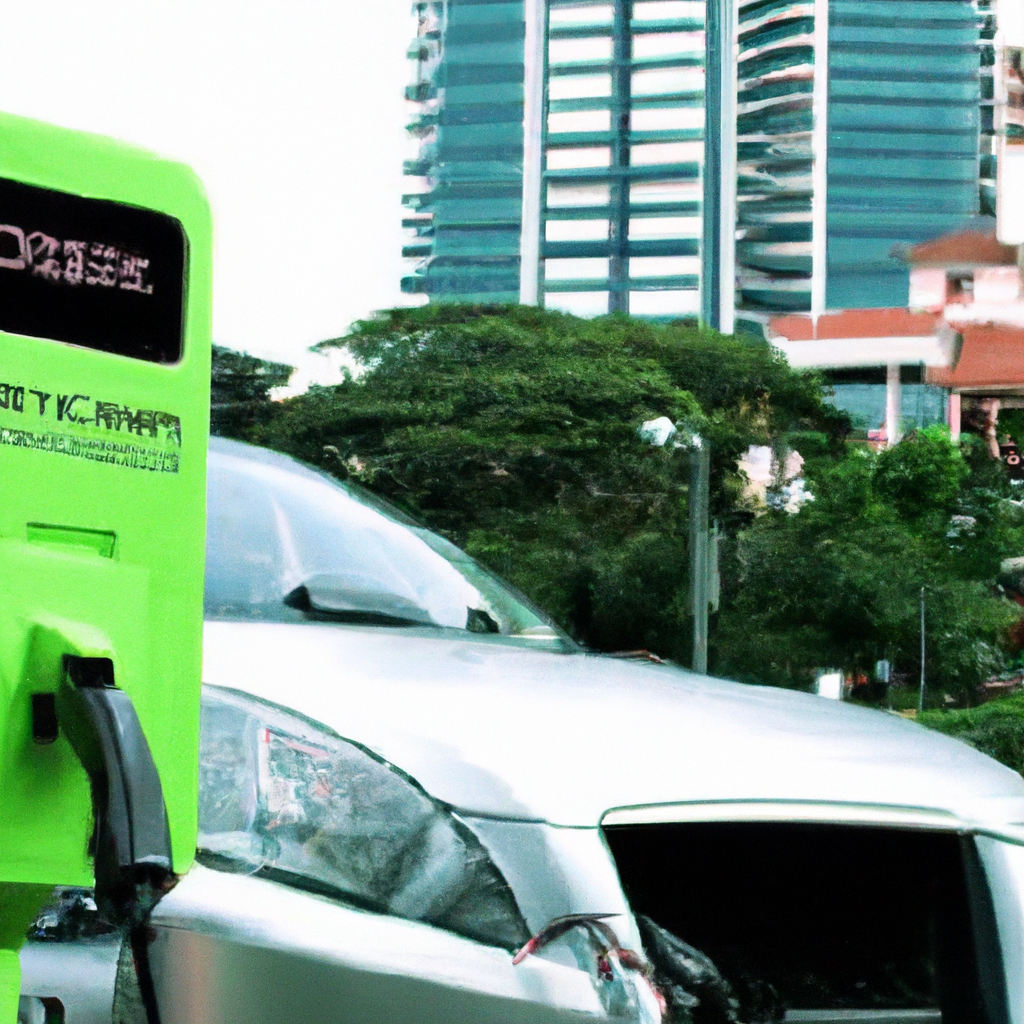EV Chargers In Multi-Unit Dwellings: Challenges And Solutions
October 22, 2023 | by Jacob Kang

If you’re navigating the world of electric vehicles, you’ve probably come across the challenge of installing EV chargers in multi-unit dwellings. It seems like a simple task at first, but as you dive deeper, you start to realize the complexities that come with it. From obtaining permission from homeowners’ associations to managing limited space for charging infrastructure, there are numerous hurdles to overcome. But fear not, because in this article, we’ll explore the challenges and solutions related to EV chargers in multi-unit dwellings. So, settle in and get ready to discover how to make EV charging a breeze in these types of environments.
Challenges of Installing EV Chargers in Multi-Unit Dwellings
Installing electric vehicle (EV) chargers in multi-unit dwellings (MUDs) poses various challenges that need to be addressed in order to make EV charging more accessible and convenient for residents. In this article, we will explore the main challenges faced when installing EV chargers in MUDs and discuss potential solutions to overcome these obstacles.

Lack of Infrastructure
Many MUDs lack the necessary infrastructure to support EV charging. This challenge encompasses various aspects, including insufficient charging stations, inadequate power supply, and the absence of EV-ready parking spaces.
Insufficient Charging Stations
In MUDs, the limited number of charging stations can drastically impact the availability and accessibility of EV charging options. Residents may not have convenient access to charging stations, leading to longer wait times and inconveniences. Increasing the number of charging stations is essential to meet the growing demand for EV charging in MUDs.
Inadequate Power Supply
Another challenge lies in the lack of sufficient power supply to support multiple EV chargers simultaneously. Traditional electrical infrastructure may not have been designed to handle the increased energy demands of EV charging. Upgrading power distribution systems can help address this issue and ensure that MUDs have the necessary electrical capacity for EV charging.
Absence of EV-Ready Parking Spaces
EV-ready parking spaces are specifically designed and equipped with the necessary electrical infrastructure to support EV charging. However, many MUDs do not have dedicated EV-ready parking spaces, making it difficult for residents to install and use EV chargers. Creating designated parking spaces with pre-installed charging infrastructure can alleviate this challenge and encourage more EV adoption in MUDs.
Space Limitations
MUDs often have limited parking space available, making it challenging to accommodate the installation of EV charging infrastructure and accommodate the charging needs of all residents.
Insufficient Parking Spaces
The lack of parking spaces in MUDs presents a significant hurdle when it comes to installing EV chargers. Allocating space for charging stations can be a complex task, especially when there are competing demands for parking area usage. Finding innovative solutions to maximize parking space efficiency while incorporating EV charging infrastructure is crucial to overcoming this challenge.
EV Charger Placement Constraints
Even if parking space is available, there may be constraints on where EV chargers can be installed within the MUD. Certain architectural or structural limitations can impact the accessibility and placement of charging stations. Collaborating with architects and engineers during the construction or remodeling phase of MUDs can help overcome these constraints and ensure that EV chargers are integrated seamlessly into the building design.

Limited Electrical Capacity
The existing electrical capacity in MUDs may not be sufficient to support widespread EV charging, leading to challenges in meeting the charging needs of residents.
Insufficient Power Distribution
Older MUDs may have outdated electrical systems that are not designed to handle the additional power demand of EV charging. Upgrading the power distribution infrastructure within the MUD is crucial to ensure that the electrical capacity can support the charging requirements of residents. Collaborating with electrical experts and utility companies can help identify and implement the necessary upgrades.
Upgrading Electrical Infrastructure
In some cases, the overall electrical capacity of the MUD might need to be increased, which involves significant upgrades to the electrical infrastructure. This process can be complex and costly, posing challenges for MUDs. Planning and securing the necessary funding for these infrastructure upgrades are essential steps in enabling EV charging within MUDs.
High Installation Costs
The cost of installing EV charging infrastructure in MUDs can be a major barrier, deterring property owners or management from pursuing such projects.
Retrofitting Existing Parking Areas
Retrofitting existing parking areas with EV charging infrastructure can be expensive, especially if there is a need for significant modifications to the electrical systems or parking layout. The cost of trenching, wiring, and installing charging equipment can add up quickly. Finding cost-effective ways to retrofit parking areas is vital to make EV charging more financially viable for MUDs.
Installing Electrical Infrastructure
Apart from retrofitting parking areas, installing the necessary electrical infrastructure is another significant cost factor. Upgrading electrical panels, wiring, and transformers to support EV charging can be a substantial investment. Exploring funding options, such as grants or incentives, can help alleviate the financial burden associated with these installations.
EV Charger Purchase and Installation
The cost of purchasing and installing EV chargers themselves can also pose a challenge. Depending on the type and specification of the charging equipment, costs can vary significantly. Additionally, the installation process requires skilled professionals, further contributing to the overall expenses. Seeking partnerships with charging equipment manufacturers or exploring bulk purchase options can help reduce the cost of EV chargers for MUDs.

Permission and Approval
Obtaining the necessary permissions and approvals for installing EV chargers in MUDs can be a complex and time-consuming process.
Obtaining Building and Electrical Permits
Installing EV charging infrastructure often requires obtaining building and electrical permits, which can involve extensive paperwork and compliance with local regulations. Navigating the permit process and ensuring compliance with building codes can be challenging, particularly for property owners or management not familiar with the specific requirements. Working closely with local authorities and hiring professionals experienced in securing permits can streamline the approval process.
Gaining Approval from Homeowners’ Associations
In MUDs governed by homeowners’ associations (HOAs), getting approval from the HOA board or committee may be necessary before implementing EV charging infrastructure. The approval process could involve presenting proposals, addressing concerns, and gaining support from other residents. Educating the HOA about the benefits of EV charging and addressing any potential reservations can help expedite the approval process.
Meeting Local Zoning Regulations
Local zoning regulations may impose constraints on the installation of EV chargers in MUDs. compliance with setback requirements, parking ratio regulations, and aesthetic guidelines can be challenging, especially if they were established before the emergence of EVs. Collaborating with local authorities and advocating for EV-friendly zoning regulations can create an environment conducive to installing EV chargers in MUDs.
Shared Parking Areas
The presence of shared parking areas in MUDs presents challenges when it comes to allocating and managing EV charging resources.
Charging Station Availability
Residents sharing parking areas may have conflicting charging needs, leading to limited availability of charging stations. Developing strategies to allocate charging resources effectively, such as time-based scheduling or charging station reservations, can help ensure fair access for all residents while avoiding conflicts.
Reserving Charging Spaces
Reserving specific parking spaces for EV charging purposes can be a practical solution in MUDs. Reserved spaces allow dedicated access to charging stations, eliminating the need for residents to compete for charging resources. Implementing reservation systems can help optimize the utilization of charging stations and streamline the charging process.
Managing Charging Spot Etiquette
Shared parking areas require residents to adhere to proper charging spot etiquette to avoid conflicts and ensure charging stations’ availability. Encouraging residents to promptly move their vehicles after charging is completed and implementing clear guidelines on charging spot etiquette can help maintain a cooperative and efficient charging environment.

Management and Ownership Issues
Ownership and management structures within MUDs can introduce additional complexities and challenges for installing EV chargers.
Shifting Responsibilities
Determining who is responsible for the installation, operation, and maintenance of EV charging infrastructure can be challenging in MUDs. The presence of different stakeholders, such as property owners, management companies, or HOAs, may complicate decision-making processes. Establishing clear lines of responsibility and fostering collaboration between stakeholders can help navigate these challenges effectively.
Budgetary Constraints
Budgetary constraints can also impact the installation of EV charging infrastructure in MUDs. Determining the financial responsibility and identifying potential funding sources can be a complex task. Exploring options for shared funding among stakeholders or leveraging government incentives can alleviate the financial burden and enable EV charger installations.
Evolving Management Models
Some MUDs are exploring innovative management models, such as community cooperatives or shared ownership structures. These models can help streamline decision-making processes and create a more coordinated approach to EV charger installations. Embracing collaborative governance models can enhance the efficiency and effectiveness of implementing EV charging infrastructure in MUDs.
Allocation of Charging Resources
Efficient allocation of charging resources is essential to ensure equitable access for all residents in MUDs.
Fair Charging Policy
Developing fair charging policies that address the needs of all residents is crucial. Instituting policies that limit charging times or establish fair pricing structures can prevent monopolization of charging resources and help distribute access more equitably among residents.
Charging Prioritization
In some cases, MUDs may need to develop prioritization strategies for charging. This could involve prioritizing certain residents based on specific criteria, such as residents with disabilities or individuals who heavily rely on their EVs for transportation. Implementing fair and transparent processes for charging prioritization can ensure that those who need it the most have access to charging resources.

Equitable Access
Ensuring equitable access to EV chargers in MUDs is a fundamental challenge that needs to be addressed.
Accessibility for All
MUDs must consider the needs of all residents, including those with limited mobility or disabilities. Providing accessible charging infrastructure, such as ADA-compliant charging stations and designated parking spaces, is essential. Collaborating with accessibility experts and incorporating feedback from residents can help create a more inclusive EV charging environment.
Education and Outreach
Educating residents about the benefits of EVs and the importance of EV charging infrastructure is crucial for promoting equitable access. Outreach programs, workshops, and informational materials can help raise awareness and address any misconceptions or questions that residents may have. Creating a sense of community around EV charging can foster inclusivity and encourage adoption.
Solutions to Overcome Challenges in Installing EV Chargers
Various solutions can help overcome the challenges faced when installing EV chargers in MUDs. Let’s explore some effective strategies and initiatives:
Community Engagement and Education
Engaging the MUD community through education and outreach programs can foster support and ensure a greater understanding of the benefits and necessity of EV charging infrastructure. Organizing workshops, seminars, or events to inform residents about EVs, charging technologies, and the installation process can alleviate apprehensions and generate excitement.
Building Infrastructure Upgrades
Collaborating with architects, engineers, and contractors during the construction or remodeling phase of MUDs can help incorporate EV charging infrastructure seamlessly. Planning for EV-ready parking spaces and upgrading electrical systems can minimize retrofitting costs and eliminate potential installation constraints.
Collaboration with Utility Companies
Working closely with utility companies can help MUDs identify potential grid capacity issues and develop strategies to improve electrical capacity. Utility companies can also provide valuable insights into energy demand management, load balancing, and tariff structures, which can optimize the charging experience for MUD residents.
Smart Charging Technologies
Implementing smart charging technologies can enhance the efficiency and utilization of charging resources in MUDs. Load management systems, demand response capabilities, and scheduling algorithms can help balance the electrical grid load, prevent overloading, and optimize charging rates. Intelligent charging solutions can also provide real-time data on charging availability, helping residents plan their charging sessions better.
Incentive Programs
Government incentives, such as tax credits, grants, or rebates, can substantially reduce the financial burden of installing EV charging infrastructure in MUDs. Encouraging property owners, management companies, and residents to take advantage of these programs can support the widespread adoption of EV chargers in MUDs.
Streamlined Permitting Processes
Collaborating with local authorities and streamlining the permitting processes can help expedite the installation of EV charging infrastructure in MUDs. Simplifying paperwork, establishing clear guidelines, and providing dedicated resources for EV charger permit applications can accelerate the approval process and minimize administrative burden.
Establishing Clear Policies
Developing clear policies around EV charging for MUDs can ensure fairness and efficient utilization of charging resources. These policies can address topics such as charging time limits, pricing structures, reservation systems, and charging prioritization. Transparency and communication about these policies with residents are essential to foster a cooperative charging environment.
Collaborative Governance Models
Exploring innovative management models, such as community cooperatives or shared ownership structures, can enable more coordinated decision-making and efficient installation of EV charging infrastructure in MUDs. Collaborative governance models can help overcome challenges related to ownership, funding, and administration, and foster a sense of shared responsibility among stakeholders.
Shared Charging Solutions
Implementing shared charging solutions, such as charging stations equipped with multiple charging ports, can optimize the utilization of EV chargers in MUDs. This approach allows residents to share charging resources more effectively, utilizing the available infrastructure efficiently without the need for excessive installation costs.
Innovative Charging Infrastructure Designs
Innovation in charging infrastructure design can help overcome space limitations and improve the overall accessibility of EV chargers in MUDs. Multi-functional EV charging stations that incorporate other amenities, such as bike racks or seating areas, can optimize space usage and enhance the overall charging experience. Wireless charging technologies and integration with solar panels are other innovative solutions that can reduce installation complexity and improve the sustainability of EV charging in MUDs.
In conclusion, installing EV chargers in multi-unit dwellings poses several challenges, including lack of infrastructure, space limitations, limited electrical capacity, high installation costs, permission and approval processes, shared parking areas, management and ownership issues, allocation of charging resources, and equitable access considerations. However, by implementing solutions such as community engagement and education, building infrastructure upgrades, collaboration with utility companies, smart charging technologies, incentive programs, streamlined permitting processes, clear policies, collaborative governance models, shared charging solutions, and innovative charging infrastructure designs, these challenges can be overcome. With concerted effort and effective strategies, EV charging can become more accessible, convenient, and widely available in multi-unit dwellings, encouraging the adoption of electric vehicles and contributing to a greener future.
RELATED POSTS
View all


